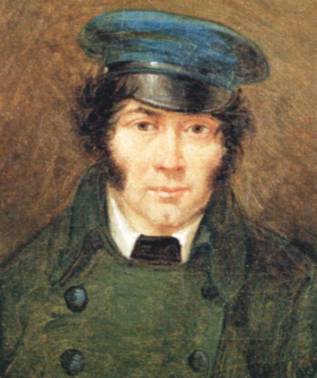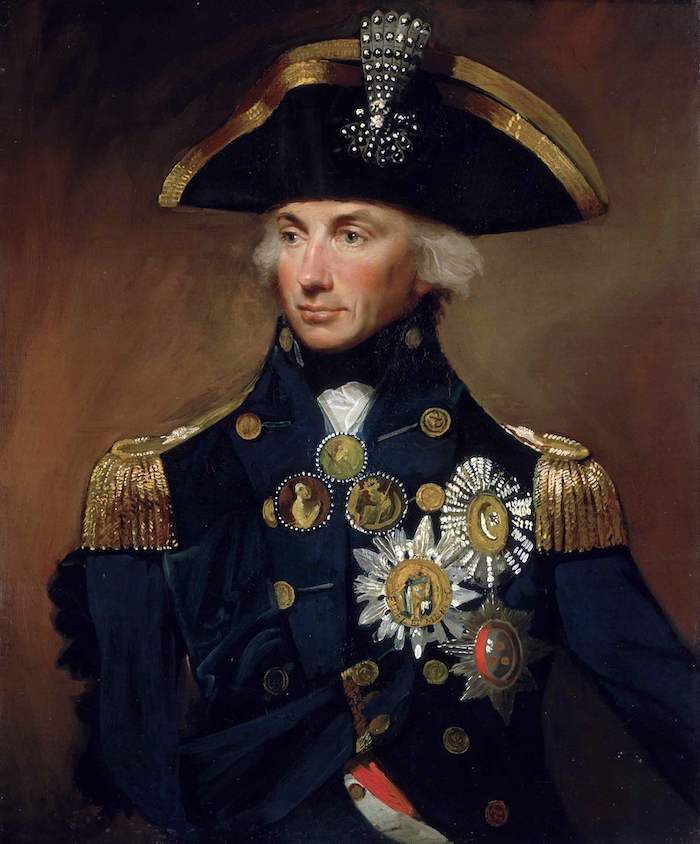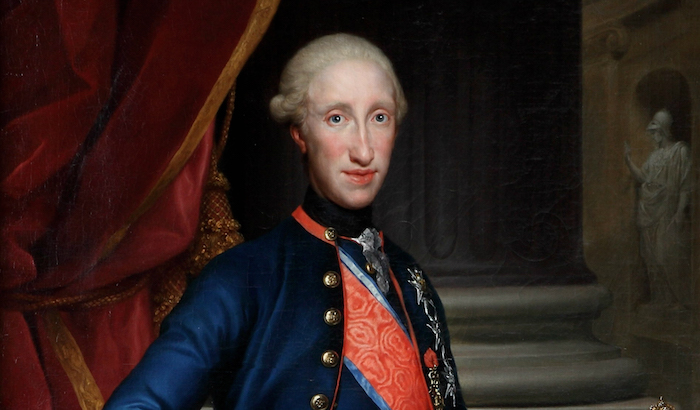In 1799, a Neapolitan admiral-turned-rebel named Francesco Caracciolo was tried for treason. The trial took place aboard a British flagship and was influenced by the bizarre King Ferdinand IV of Naples, the motivated social climber Lady Emma Hamilton of England, and Admiral Horatio Nelson, the greatest naval commander in human history. The weird social and political situation surrounding the trial dogged Nelson for the rest of his career. And even though Caracciolo was hanged, he reappeared later in a most unexpected way. It’s a convoluted story, and is great inspiration for the gaming table!
This post is brought to you by beloved Patreon backer Justin Moor. Thanks for helping keep the lights on! If you want to help keep this blog going alongside Justin, head over to the Patreon page – and thank you!

First, some context. The French Revolution of 1789 led to the establishment of the First Republic in 1792 and the execution of the former King of France in 1793. These events precipitated a series of wars between France (ruled to varying degrees by ‘the people’) and the crowned heads of Europe, who saw French Republicanism and representative democracy as an existential threat. Britain in particular was at war with France more or less continuously from 1792 to 1815. At sea, the 1798 Battle of the Nile gave Britain control of the Mediterranean. The victorious British commander, the one-eyed, one-armed Admiral Horatio Nelson, became a hero back in Britain. Nelson was a vain and attention-hungry man, yet an absolute genius who loved his sailors and was loved by them.
Of interest to our story are events in Italy. The Kingdom of Naples and the Kingdom of Sicily were technically two separate states, but were both ruled by the same man: King Ferdinand IV of Naples/King Ferdinand III of Sicily. Later, he would formally merge the two kingdoms, founding the Kingdom of the Two Sicilies (of which he was Ferdinand I). Technically that hadn’t happened yet by the time of Caracciolo’s trial, but… myeh. Ferdinand was an odd fellow. His oldest brother was mad. His next-oldest was possibly mentally handicapped. Consequently, he was raised without any restrictions his family feared might tax his mind. He liked to curse in Italian and poop in front of people (though this was not the custom at the time), and he hosted enormous hunts with thousands of beaters. His wife, a Habsburg, did most of the actual ruling.
Ferdinand was related to the deposed and executed King of France, so we shouldn’t be surprised he fought a few wars against the First Republic. In 1798, after the Battle of the Nile, Admiral Nelson was dispatched to Italy to provide Ferdinand assistance from the sea. The terrestrial part of the war went badly, and Ferdinand fled Naples to Sicily. Rebels with French backing established a republic in Naples. Nelson was in no great hurry to retake the city, though. First, the broader military situation discouraged it. Second, he hard orders to protect Ferdinand’s family, and Ferdinand’s queen wanted Nelson in Sicily for security. And third, Nelson had begun an affair with Emma Hamilton, the wife of the British ambassador to Ferdinand’s court. Emma (more properly, Lady Hamilton) was secretly the daughter of a blacksmith and had clawed her way up the social ladder while concealing her origins every step of the way. She was a celebrity in her own right, having appeared in a series of famous portraits by artist George Romney.

Which brings us to Francesco Caracciolo. He was an admiral in the Neapolitan fleet under Ferdinand. He’d fought beside Nelson on multiple occasions, earning a reputation as brave, competent, and sometimes reckless. They’d worked together to smuggle the court out of Naples under cover of darkness. But when a republic was declared in Naples, Caracciolo switched sides, possibly to save his Neapolitan property from the new government. He took command of the defense of the Bay of Naples against Nelson. It didn’t matter. Six months after the republic was established, Naples fell to a ground assault. Caracciolo was captured hiding in the hills near the city.
Caracciolo was dragged before Nelson in chains. He was half-starved and had a long, gray beard. Nelson ordered six Neapolitan naval officers to form a court-martial, which he oversaw. The court met aboard Nelson’s flagship, HMS Foudroyant (‘Thunderer’; she was a captured ex-French ship). There could be no doubt of Caracciolo’s guilt. Different witnesses gave different accounts of his defense. The most popular is that he argued that since King Ferdinand fled in the middle of the night, taking all of Naples’ money with him, the King had betrayed Naples first. Caracciolo, then, did nothing wrong. Of course, Caracciolo was part of Ferdinand’s evacuation, so the excuse rings a bit hollow. Half the jury voted to execute him immediately. The other half voted to wait until they heard what Ferdinand wanted. Nelson broke the tie. He ordered Caracciolo taken to the Neapolitan frigate Minerva, hanged that afternoon, and the corpse thrown in the bay with cannonballs strapped to it.
Emma Hamilton dined with Nelson in the wardroom that night. The British officers were agitated over Nelson’s swift justice. But when word arrived that Caracciolo was dead, Lady Hamilton rose and gave a toast to dead traitors.

The trial of Francesco Caracciolo became a blot on Admiral Nelson’s sterling reputation. No one disputed that Caracciolo was guilty or that the punishment for treason was death. But there were irregularities in the case that made people uncomfortable. This was evident as soon as Nelson’s dinner with his unquiet officers that night. For one, Caracciolo had been a friend. He and Nelson had fought together and dined together. For Nelson not to extend him a few gentlemanly courtesies – shaving him, feeding him, giving him access to an attorney – did not reflect well on Nelson’s character as a member of the British upper class. So too did hanging Caracciolo instead of acceding to his request to be shot, as befitted his rank. Of course, it’s exactly this sort of preferential treatment for the wealthy and well-bred that the French Republic was so upset about in the first place. Had Caracciolo been a normal person, these complaints would not have arisen.
But there were other complaints too. From a Christian perspective, Caracciolo ought to have been given twenty-four hours to compose his thoughts and repent before he was executed. He also ought to have been given a Christian burial in a churchyard instead of being chucked in the bay like a mobster with concrete shoes. From a juridical perspective, Caracciolo ought to have been tried in a less prejudicial setting. Indeed, he requested an appeal for just that reason, but Nelson refused. Nelson also spoke no Italian, yet Caracciolo had no interpreter. Presumably his words were translated for Nelson by the Neapolitan judges – a potential conflict of interest on their part.
And there were political concerns back home. British warships are, legally, British soil (sort of; it’s more complicated than that). Caracciolo was hanged on a Neapolitan warship. Ought he not have been tried there too? Worse, Caracciolo was only the first in a long series of anti-democratic purges by King Ferdinand that Nelson abetted. None of this was a good look for England. Finally, there were rumors that Emma Hamilton, Nelson’s mistress, put her thumb on the scale. She was known to have swayed Nelson in previous courts-martial and was seemingly the only person aboard Foudroyant happy to see Caracciolo hanged. Was Nelson’s judgement compromised by his affaire de cœur?

Caracciolo had one last surprise in store. Once Naples was firmly in Royalist hands, Ferdinand wanted to be on the scene. He didn’t trust his rebellious subjects, so he left his capable wife in Sicily (probably a mistake), and moved his capital to HMS Foudroyant, anchored in the Bay of Naples. Two days after his return, he was walking the deck and spied – to his shock – the body of Francesco Caracciolo rising from the waves! Everyone held their breath. How would the erratic Ferdinand react? Then someone (possibly Lord Hamilton, the British ambassador) defused the situation by quipping that Caracciolo clearly couldn’t pass on until he’d sought his majesty’s pardon.
It was later revealed that some rebels somehow dove down and dredged up Caracciolo’s corpse, rigged it up with wood and cork, and released it at the right moment so it seemed to surge from the waters, fully upright, to give King Ferdinand a scare. Caracciolo surely appeared ghoulish, given he’d been dead two weeks, at least some of it underwater. It’s a bizarre story, but attested to by multiple eyewitnesses.
Some fishermen towed the standing figure to shore and hastily buried it on the beach. Later, public opinion turned. Caracciolo was, after all, fighting for Italian democracy. His corpse was exhumed (for the second time, if you count its retrieval from the sea bed) and reburied in a proper graveyard.

This court-martial is amazing inspiration for gaming material. You have a one-eyed, one-armed beloved war hero overseeing the trial of a prisoner whose guilt is beyond question, yet whose situation has an astonishing number of irregularities. In a fictional adventure inspired by these events, I’d move your Ferdinand-analogue out to the ship early, so he can be present for the court-martial. Then lean into those irregularities! Introduce a situation that prolongs the trial. Maybe a storm comes up so your Caracciolo-analogue can’t be ferried to the ship where he’s to be hanged. Maybe a dignitary’s unexpected arrival (or even the King’s) temporarily halts the proceedings.
Now that events aren’t moving faster than the PCs can react, just turn them loose on the situation! Let them bite on whatever hooks they please. Curious PCs might try to ferret out whether your Lady-Hamilton-analogue has really swayed the verdict and why. Politically-minded PCs might curry favor with patrons back home by moving the trial off British-analogue soil. Others might curry favor with Ferdinand by trying to accelerate the trial. Religiously-minded PCs might try to change the timing of the execution and the manner of burial. Fairness-minded or revolutionary PCs might even try to smuggle your Caracciolo-analogue off the ship!
What’s great about this situation is that there are a bunch of interesting plot hooks and multiple interesting PCs (Nelson, Lady Hamilton, and King Ferdinand) all bound up in a single constrained space (HMS Foudroyant). Assuming you’ve got some motivated players, you can really just have them be present in this unusual situation and let their actions and motivations ping-pong off the motivations of the major NPCs and just see where it goes. With a little luck, it should be a tight, fast-moving, low-prep evening.

Sources:
The Nelson Touch: The Life and Legend of Horatio Nelson by Terry Coleman (2002)
Nelson and the Hamiltons by Jack Russel (1969)
Fiddlers and Whores: The Candid Memoirs of a Surgeon in Nelson’s Fleet (1807/2006)






